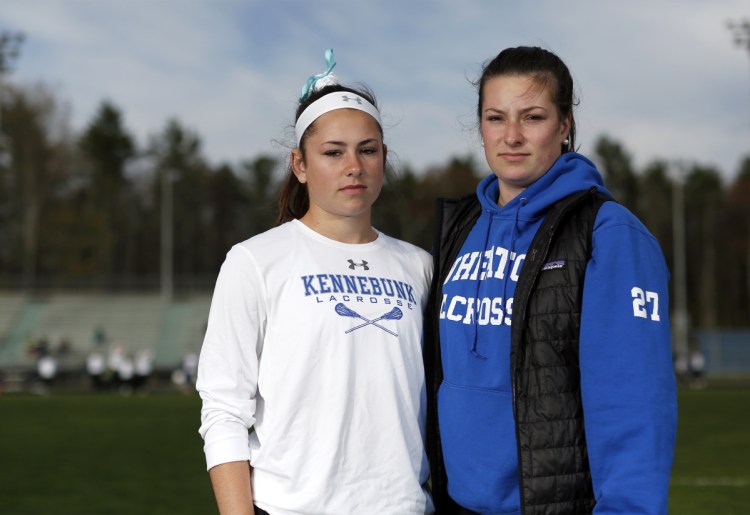KENNEBUNK — Joe Schwartzman has seen it as a father and an athletic director: Concussions happen frequently in girls’ soccer.
“Over the last four years, we’ve had a lot more concussions in soccer than in football, and we’ve had more in girls’ soccer (than boys’ soccer),” said Schwartzman, the AD at Kennebunk High. Two of the girls diagnosed with concussions were his daughters Hallie (in 2014 as a freshman) and Kyra (in 2015 as a senior).
Twelve years of national data show concussions happen more frequently in girls’ soccer than in any other high school sport.
One concussion occurred for every 6.2 girls playing high school soccer in the 2016-17 school year, according to a study conducted by Dr. Wellington Hsu, a Northwestern University professor of orthopaedic surgery. The ratio for football players was 1 concussion for every 8.8 participants; for boys’ soccer players, 1 in 17.2.
Based on data from the National High School Sports-Related Injury Surveillance Study and the National Federation of State High School Association’s participation survey, Hsu’s research concluded female athletes in general and girls’ soccer players in particular are more prone to concussions.
“We did not expect it,” Hsu said. “Looking at concussions as a proportion of all injuries, girls’ soccer is definitely the highest, which is somewhat alarming.”
GENDER DIFFERENCES IN SPORTS
Hsu’s findings did not come as a surprise to Paul Berkner, director of the Maine Concussion Management Initiative at Colby College. Berkner said not enough attention is paid to the risk for concussion among girls playing sports.
“I think football has taken the focus because the vast majority of the media is focused on (concussions in) football,” he said.
Gender differences in concussion frequency also are found consistently in basketball and softball/baseball.
Why are girls more susceptible to concussions and their harmful effects?
Hsu’s study suggests three possible reasons for the high risk in girls’ soccer: a lack of protective gear, an increased emphasis on in-game contact and a potential increase in heading the ball.
Another theory is female athletes have less upper body strength, particularly in the neck, to absorb a blow and keep the head stable.
“I think it’s just the nature of the sport,” said Hallie Schwartzman. “All of the contact is body-to-body contact and the ball is in the air a lot, especially at the high school level. So girls are jumping up and whether they’re hitting their heads, or hitting their head with the ball, there’s that aspect (of contact).”
DEBILITATING EFFECTS
Both Schwartzmans recovered from their concussions to excel academically and athletically in high school and are now college student-athletes, Kyra at Wheaton Collge and Hallie at Colby.
But Hallie clearly remembers the debilitating effect of a brain injury.
“I was trying to take a math test and I couldn’t think of anything,” she said. “I knew that I knew it, but my brain was just so scatterbrained that I couldn’t put together what I needed to know.”
Steve Craig can be contacted at 791-6413 or:
Copy the Story LinkSend questions/comments to the editors.




Success. Please wait for the page to reload. If the page does not reload within 5 seconds, please refresh the page.
Enter your email and password to access comments.
Hi, to comment on stories you must . This profile is in addition to your subscription and website login.
Already have a commenting profile? .
Invalid username/password.
Please check your email to confirm and complete your registration.
Only subscribers are eligible to post comments. Please subscribe or login first for digital access. Here’s why.
Use the form below to reset your password. When you've submitted your account email, we will send an email with a reset code.